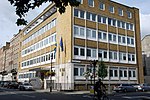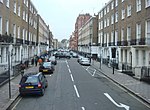Portman Estate
1764 establishments in EnglandArchitecture of LondonBuildings and structures in the City of WestminsterDistricts of the City of WestminsterFamily-owned companies of the United Kingdom ... and 4 more
Housing organisations based in LondonPortman estatePortman familyPrivately owned estates in London

The Portman Estate, covering 110 acres of Marylebone in London’s West End, was founded in 1532 when the land was first leased to Sir William Portman.The Portman Estate also has two rural estates in Buckinghamshire and Herefordshire. In addition to its core landlord operation, The Portman Estate runs The Portman Foundation, a charitable trust which supports charities and other causes which are located in or benefit the Marylebone area.
Excerpt from the Wikipedia article Portman Estate (License: CC BY-SA 3.0, Authors, Images).Portman Estate
Bryanston Mews East, London Marylebone
Geographical coordinates (GPS) Address Nearby Places Show on map
Geographical coordinates (GPS)
| Latitude | Longitude |
|---|---|
| N 51.517833333333 ° | E -0.16020277777778 ° |
Address
Bryanston Mews East 11
W1H 2DB London, Marylebone
England, United Kingdom
Open on Google Maps










